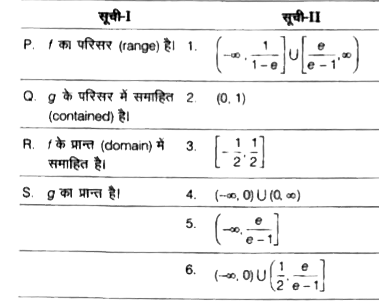x2 के सापेक्ष tan−1(sinx−cosxsinx+cosx), जहाँ (x∈(0,π2)) का अवकलज है
2
1
12
23
The correct Answer is:A
Step by step video, text & image solution for (x)/(2) के सापेक्ष tan^(-1) ((sin x -cos x)/(sin x+ cos x)), जहाँ (x in (0, (pi)/(2))) का अवकलज है by Maths experts to help you in doubts & scoring excellent marks in Class 12 exams.
Updated on:21/07/2023Topper's Solved these Questions
- JEE MAIN 2019BOOK - JEE Main & Advanced (Hindi Medium)CHAPTER - JEE MAIN 2019EXERCISE - 9 January, Shift-I
30 Videos
- JEE MAIN 2019BOOK - JEE Main & Advanced (Hindi Medium)CHAPTER - JEE MAIN 2019EXERCISE - 9 January, Shift-II
30 Videos
- JEE MAIN 2019BOOK - JEE Main & Advanced (Hindi Medium)CHAPTER - JEE MAIN 2019EXERCISE - 12 April, Shift -I
30 Videos
- JEE ADVANCED सोल्वड पेपर्स 2018 BOOK - JEE Main & Advanced (Hindi Medium)CHAPTER - JEE ADVANCED सोल्वड पेपर्स 2018 EXERCISE - पेपर 2 (खण्ड 3)
4 Videos
- JEE MAIN QUESTION PAPER 2013BOOK - JEE Main & Advanced (Hindi Medium)CHAPTER - JEE MAIN QUESTION PAPER 2013EXERCISE - PART-C - गणित (MATHEMATICS)
30 Videos
Similar Questions
माना 0<θ<π2 है। यदि अतिपरवलय x2cos2θ−y2sin2θ=1 की उत्केन्द्रता 2 से अधिक है, तो इसके नाभिलम्ब की लम्बाई जिस अन्तराल में है, वह है
View Solution(1−t61−t)3 के प्रसार में t4 का गुणांक है
View Solutionयदि एक सम षट्भुज के छः शीर्षो में से तीन यादृश्चिक चुने जाते है, तो इन चुने गए शीर्षो द्वारा बने त्रिभुज के समबहु होने की प्रायिकता है
View Solutionमाना की E1={x∈R:x≠1औरxx−1>0} और E2={x∈E1sin−1(loge(xx−1)} एक वास्तविक संख्या (real number) है|
(यहाँ प्रतिलोम त्रिकोणमितीय फलां (inverse trignometric function) sin−1x,[−π2,π2] में मान धारण करता है|
माना की फलन: f:E1→R,f(x)=loge(xx−1) के द्वारा परिभाषित है
और फलन f:E2→R,g(x)=sin−1lloge(xx−1) के द्वारा परिभाषित है|

दिए हुए विकल्पों में से सही विकल्प है
View Solutionदो समान्तर समतलों 2x+y+2z=8 तथा 4x+2y+4z+5=0 के बीच की दूरी है|
View Solution∫2sinx(3+sin2x)dxisequa<o 12ln∣∣∣2+sinx−cosx2−sinx+cosx∣∣∣−1√2tan−1(sinx+cosx√2)+c 12ln∣∣∣2+sinx−cosx2−sinx+cosx∣∣∣−12√2tan−1(sinx+c0sx√2)+c 14ln∣∣∣2+sinx−cosx2−sinx+cosx∣∣∣−1√2tan−1(sinx+c0sx√2)+c noneofthese
View SolutionIf 0
View Solutionint_ (0) ^ ((pi) / (2)) (sin x) / (sin x + cos x) dx = int_ (0) ^ ((pi) / (2)) (cos x) / (sin x + cos x) dx = int_ (0) ^ ((pi) / (2)) (dx) / (1 + cot x) = int_ (0) ^ ((pi) / (2)) (dx) / ( 1 + time x) = (pi) / (4)
View SolutionThe derivative of tan−1(sinx−cosxsinx+cosx), with respect to x2, where x∈(0,π2) is:
View SolutionThe derivative of tan−1(sinx−cosxsinx+cosx), with respect to x2, where (x∈(0,π2)) is
View SolutionProve that cosx+sinxcosx−sinx−cosx−sinxcosx+sinx=2tanx
View Solutionमूल्यांकन कीजिए -
cos(2cos−1x+sin−1x),x=15, जहाँ 0≤cos−1x≤π और −π2≤sin−1x≤π2.
View Solution∫π/20sinxcosx(1+2sinx)(1+sinx)dx=
View SolutionWrite the simplest from of tan−1(cosx−sinxcosx+sinx),0<x<π2
View Solutionनिम्नलिखित फलनों का x के सापेक्ष अवकलन कीजिए :
(sin−1x)m(cos−1x)n
View Solution
